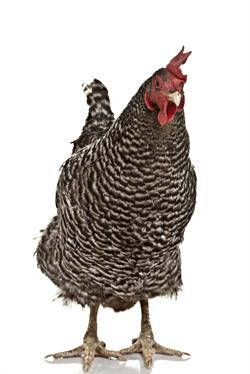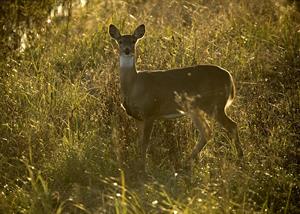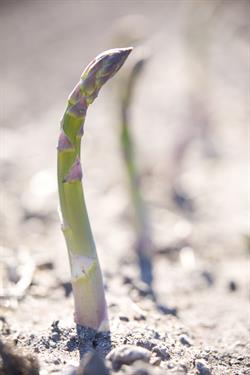As my wife and I sat down for lunch one day, I looked at our plates and thought about where the food originated. The venison came from a doe that I had taken with a crossbow behind our house. The tomatoes that topped our burgers came from our garden, as did the potatoes and chives in a side dish. Our yellow squash crop had failed to materialize, but we had swapped a jar of wineberry jam for a “mess” of crooknecks from a neighbor. Onions from our garden added flavor to the squash. For dessert, we enjoyed blackberry jam on toast. I had picked the berries from vines that line our yard and Elaine made the jam. That evening, we enjoyed omelets cooked with eggs laid by our Rhode Island Reds. Once again, tomatoes, chives, and onions from our garden added zest to the meal.
Our lives weren’t always like this. We both grew up in typical American suburbs marked by carpets of grass and big-box stores. But we wanted to practice a more sustainable lifestyle. Today, we live on 38 rural acres with a fishable creek and wildlife, wild berries, and nuts in abundance.
You don’t need to live out in the country to be more self-sufficient. Whether you live on an urban lot or in a rural landscape, every one of us can eat better (and yes, cheaper) and be better stewards of the environment if we practice a locavore philosophy. Following are a few steps that anyone can take.
Grow a Garden and Fruit Trees
Just about anyone can plant a garden, fruit trees, and berry vines behind their house. Our orchard consists of three apple, two cherry, and one crabapple tree. Last year, our Dolgo crabapple produced fruit for the first time, and we enjoyed several loafs of crabapple bread. (Crabapples can be quite sour off the tree but delicious when cooked.)
Our garden is not large, but it produces enough strawberries, asparagus, tomatoes, potatoes, onions, and chives to add variety to our meals. Folks who have raised their own gardens don’t have to be told how their tomatoes flaunt far superior taste compared with those supermarket globes that have been shipped from who knows what state or country and treated with who knows what chemicals to give them their perfectly red color.
If you have limited space in your backyard, there are other options. One is a container garden that can sit on a deck or balcony. Many fruits and vegetables thrive in containers, and even fruit trees can be successful in containers. A second option is a garden in the front yard. There is a movement to eliminate grass in favor of native plants — including edibles — that require less water and no mowing. If you keep up with garden care (pulling weeds, pruning dead leaves and branches), it can be a welcome addition to the neighborhood scenery. If you don’t have access to a balcony or yard, a community garden can offer a place to get your hands in the dirt.
Raise Chickens
Elaine and I began raising chickens in 2011, and that was one of the best decisions we ever made. I have never encountered a creature that is useful in so many ways. We consume the eggs and eventually the hens themselves when their egg-laying days are over. But we also use their manure and the straw that lines the henhouse floor as fertilizer and mulch for the garden and our fruit trees.
 Come fall, when our garden has finished producing for the year, we release the chickens into the garden for several months and let them eat the insects — and the egg cases and larva that would produce new threats to our plants the next growing season. During their non-stop scratching in the soil, the chickens either locate the insects or disrupt their life cycles. Our birds also scarf down weeds that have grown up over the summer. The chickens and the straw mulch from the henhouse largely eliminate the need to weed the garden. And, of course, the chickens are fertilizing next year’s garden.
Come fall, when our garden has finished producing for the year, we release the chickens into the garden for several months and let them eat the insects — and the egg cases and larva that would produce new threats to our plants the next growing season. During their non-stop scratching in the soil, the chickens either locate the insects or disrupt their life cycles. Our birds also scarf down weeds that have grown up over the summer. The chickens and the straw mulch from the henhouse largely eliminate the need to weed the garden. And, of course, the chickens are fertilizing next year’s garden.
Before World War II, it was common for folks all over the country to raise backyard chickens, and that practice is enjoying a renaissance today as many urban planning districts have done away with restrictions on homeowners possessing birds. Local agencies may have restrictions on roosters, but few places forbid hens anymore. County or city laws may also stipulate property size required, number of chickens allowed, space required between a chicken coop and the property line, and other considerations.
Gather Wild Fruits and Nuts
Except for strawberries, I have never really been interested in planting berry and nut producers behind our house. Elaine and I have always preferred to gather the wild versions. Last summer, we picked 11 gallons of wild blackberries, raspberries, dewberries, and wineberries — a banner crop for sure. (Wineberries are an invasive that competes with native berries, so I’m doing my part to eat them so their seeds won’t spread!)
The native wild blackberry is the main fruit that we gather. Known for their antioxidant content, wild blackberries are also good sources of Vitamins C and K as well as bioflavonoids. During the summer month that we call “berry season,” Elaine and I prowl the forest openings on our land and on neighbors’ properties where we have permission to “go-a-berrying.”
 The end of summer does not mean the end of our wild fruit gathering. Come September, wild grapes and cherries ripen (wild grapes flourish across most of the country). Next come paw paws and persimmons. Hickory trees are an important hardwood across more than half the country, and in southwest Virginia where we live, two species produce very tasty nuts: the shagbark and the mockernut. Wild walnut trees drop their bounty in October, and these nuts are great in homemade bread.
The end of summer does not mean the end of our wild fruit gathering. Come September, wild grapes and cherries ripen (wild grapes flourish across most of the country). Next come paw paws and persimmons. Hickory trees are an important hardwood across more than half the country, and in southwest Virginia where we live, two species produce very tasty nuts: the shagbark and the mockernut. Wild walnut trees drop their bounty in October, and these nuts are great in homemade bread.
All this berry and nut gathering has other benefits as well. Combing the woods and fields for nature’s bounty is excellent exercise, enables us to enjoy bird and wildlife watching, and (I admit) I even scout for deer and turkeys while doing so.
If you don’t have woodlots or fields near where you live, plant the domestic versions of these berry and nut producers in your backyard. All I did to encourage wild blackberries to grow in our backyard was to stop mowing several strips that border the woods. Blackberry seeds were already in the soil’s seed base, and I’m sure that various songbirds did their part with droppings as well.
Hunt Locally
Many Ikes enjoy pursuing America’s favorite game animal: the white-tailed deer. As much as I enjoy the pursuit, I relish consuming venison and enjoying the health benefits of doing so. Venison is lower than beef in saturated fat, cholesterol, and calories and higher in iron. Venison contains large amounts of the B vitamins, which are necessary for helping break down proteins and for blood cell formation.
 All of my whitetails are usually killed on our own land or on farms nearby. Even Ikes who live in cities typically can get out to rural areas within an hour’s drive or less. I have found that many rural landowners are receptive about letting folks hunt on their land as long as we promise to be ethical and obey all of a property owner’s dictates. Since many farmers suffer from an overabundance of deer, I have also found that promising to kill only does is a superb way to gain access to a property.
All of my whitetails are usually killed on our own land or on farms nearby. Even Ikes who live in cities typically can get out to rural areas within an hour’s drive or less. I have found that many rural landowners are receptive about letting folks hunt on their land as long as we promise to be ethical and obey all of a property owner’s dictates. Since many farmers suffer from an overabundance of deer, I have also found that promising to kill only does is a superb way to gain access to a property.
I am usually able to kill four or five turkeys in the spring and fall seasons, and that meat supplements our venison quite nicely. Add in the odd squirrel or rabbit and, really, why would we need to go to a supermarket meat aisle?
Fish Locally
Farm ponds exist in even the most heavily populated counties. We gain permission to fish farm ponds by offering to keep the panfish and release the bass.
I am all for catch and release when it comes to species like native brook trout and river smallmouths as well as lake largemouths. But there is absolutely nothing wrong or harmful to the environment about keeping fish to eat, especially species such as pond bluegills, lake crappie, and stocked trout. Behind our house, the creek hosts an abundance of rock bass and redbreast sunfish. Their fillets prove to be quite tasty. I encourage you to take a kid fishing and eat those fish.
Where do you fish if you don’t have a stream in your backyard or a pond at a neighboring farm? Your state Department of Natural Resources or Game Department Web site will have a list and maps of places to fish locally — the closest lake, the closest rivers. State agencies do an excellent job of providing that information as well as local requirements.
Support Local Farmers Markets
 Farmers markets and food co-ops can be found in communities across the United States, and they are wonderful ways to keep rural America rural. Keeping these areas in farmland (rather than being developed for housing or industry) benefits local wildlife and can provide places to hunt (with permission).
Farmers markets and food co-ops can be found in communities across the United States, and they are wonderful ways to keep rural America rural. Keeping these areas in farmland (rather than being developed for housing or industry) benefits local wildlife and can provide places to hunt (with permission).
I’d rather get my corn from the farmers market down the road than from California or Argentina. Think of your carbon footprint with that! A city person can decrease his or her carbon footprint simply by purchasing local foods from a farmers market.
Elaine and I especially like to buy heritage apples at farmers markets and co-ops. After World War II, the food producing conglomerates, in their quest for efficiency and “pretty store-shelf fruit,” systematically eliminated the wide variety of apples that were grown across this country. We have been left with a few varieties that look great on store shelves but provide little in the way of taste (think Red Delicious apples that taste like moist cardboard). Rediscover the taste and utilitarian nature of heritage apples and many other fruits and vegetables by visiting farmers markets and co-ops. This diversity is also good for wildlife and the future of our food supply.
Battle Locavore Myths
Recently, Elaine and I spent several days with a couple who live in a very urban area. Over dinner one evening, we touted the virtues of our locavore philosophy. The lady said it would be impossible for them to practice that lifestyle. I asked her if she had a backyard, a farmer’s market nearby, a husband who liked the outdoors, a desire for fresh food, or an inclination to know where her food come from. She laughingly said yes, and I then told her that she had the potential to become a locavore.
It may be that raising chickens and produce, visiting local farmers markets, and bringing home a deer or two every fall would only account for five percent of the couple’s food needs. But think what a difference it would make if more people practiced this locavore philosophy.
There are many wonderful guides to foraging for and raising your own food. Here are a few of my favorites:
- A Field Guide to Trees and Shrubs (Peterson Field Guides) by George Petrides (one of many excellent field guides on tree and shrub identification), Houghton Mifflin (1973)
- Animal, Vegetable, Miracle by Barbara Kingsolver (the best book I have read on the locavore philosophy), Harper Perennial (2008)
- Slow Food USA (Web site about farming, sustainability, the locavore movement, and much more), www.slowfoodusa.org
- Storey’s Guide to Raising Chickens (3rd edition) by Gail Damerow, Storey Publishing (2010)